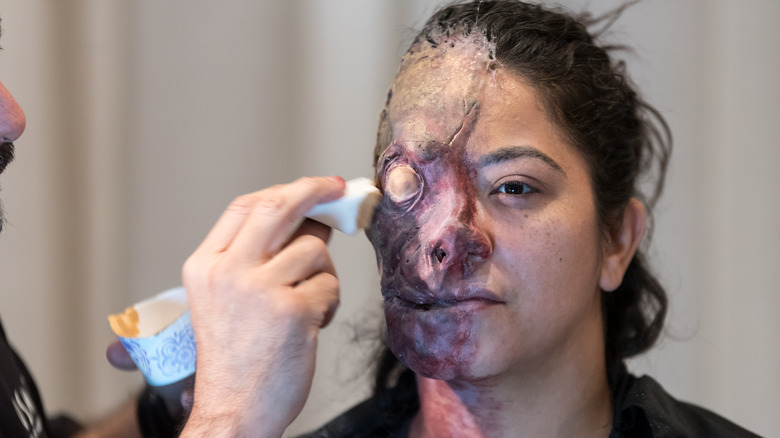What Are Face Adhesives, And How Do You Use Them?
There are millions of ways to do your makeup, from a natural face to bright and bold styles, and even horror looks for Halloween costumes. Usually, standard products like foundation, blush, and eyeshadow are used. However, if you want to enhance your look with special effects or change certain facial features, you will need a special type of makeup, which includes the use of prosthetics and face adhesives. While generally known for creating fake injuries and monster faces, there are many other ways to use prosthetics. The Hair & Makeup Artist Handbook explains that they can also make an actor look older, weigh more, or appear to be someone else entirely.
Prosthetic makeup is not exclusive to actors though. Cosplayers also use these pieces to change their facial features in both subtle and dramatic ways. A common cosplay prosthetic adds a point to each ear to make them look more elf-like. Prosthetics are made out of latex, silicone, or gelatine. They're either molded, cast, or sculpted, and once they're in the right shape, they are trimmed and applied to the face with an adhesive.
Types of prosthetic adhesives
The type of adhesive used to apply these prosthetics depends on how skilled the makeup artist is and if the person wearing them has any allergies. Liquid latex is most commonly used, but it can cause an allergic reaction because of the ingredients. The elasticity and moldability of this adhesive make it a good choice for faces that need to move a lot as people talk and change their expressions, according to Art Hearty. The last thing you want is for the prosthetic to fall off.
Another option is Elmer's glue. Yes, the white liquid or purple stick that is commonly used for arts and crafts. It's a good choice for beginners who need to practice more before purchasing a more advanced adhesive. They're easy to find at most stores but not as durable as the other options.
Spirit gum is a great choice if the wearer has a latex allergy. It feels light on the skin but can firmly grip the prosthetic. However, only skilled makeup artists should use this product because it is complicated to remove. It won't come off the skin unless you have an adhesive solvent.
How to apply them
When using adhesives to apply prosthetics, you need to start with a clean face and hands. You can wipe them with rubbing alcohol to ensure the skin is clear of any oil or makeup. The application process for liquid latex and spirit gum is very similar. They both require you to use tools like wedge sponges or Q-tips because they will ruin the bristles on makeup brushes, according to Camera Ready Cosmetics. With the tool of your choice, apply a thin layer of adhesive to the skin then wait for it to become tacky. Last Looks FX & Beauty Supply recommends checking if it is somewhat dry by tapping it with your finger. If it feels sticky but not wet, you can firmly press the prothetic to the area.
Using Elmer's glue requires more steps than the other adhesives. You can use the same tools to apply the white liquid glue from the bottle. Building up the layers is the trick to making this glue strong enough to hold a prosthetic (via Keneshi Project). First, apply the adhesive to the skin and use a hairdryer to dry it quickly. Continue this step until you have at least four layers. Then add more glue, but don't dry it. When it's tacky, press the prosthetic into the adhesive. Once everything is dry, you can apply your makeup to finish the look.


